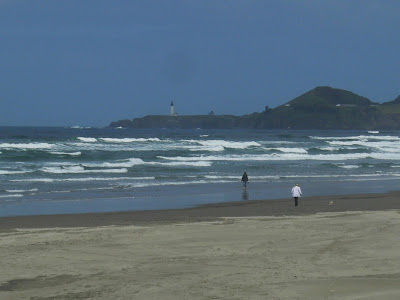 |
| Crescent City Beach |
We couldn’t leave Crescent
City without enjoying the pretty crescent shaped beach. We took Java along and she had a ball running
through the sand after her Frisbee.
Leonard even drew a heart in the sand with our initials - wow, a rare
romantic moment! It seemed rather
touching since I had played here as a small child during the late 50’s. I was on vacation with my parents and we stayed
in a cute sea-side B&B; I was quite delighted to have my very own room with a
dormer window and lace curtains. Leonard
and I decided to try and find the house but we soon realized that it had probably
been swept away in the devastating ocean surges of the 1964 tsunami, triggered
by an earthquake in Anchorage Alaska. It
took only 4 ½ hours for the first of a series of tsunami waves to reach
Crescent City. The shape of the sea
floor and bay caused the waves to amplify.
The final 20-foot wave inundated the harbor and crashed into land
covering 29 city blocks, 11 people lost their lives. Now a large city park occupies the area along
the beach where these summer cottages and B&B's once stood – no wonder I
couldn’t find that cute little house! Crescent
City again faced a series of tsunami waves after the Tohoku earthquake in March
2011. The boat basin’s infrastructure
was destroyed – 16 boats sank and many more were damaged. Now barely over a year ago, less than half
the docks have been replaced. Most of
the existing docks are only temporary, including the guest dock we were
on. This California town understands the
destructive power and financial loss of a tsunami perhaps better than any other
West Coast town!
 |
| Java Playing Beach Frisbee |
 |
| Wow! a Romantic Jesture |
 |
| Marina Docks Before the 2011 Tsunami |
 |
| Docks Destroyed After the 2011 Tsunami |
 |
| The Sun Sets over a Hopeful Community |















































